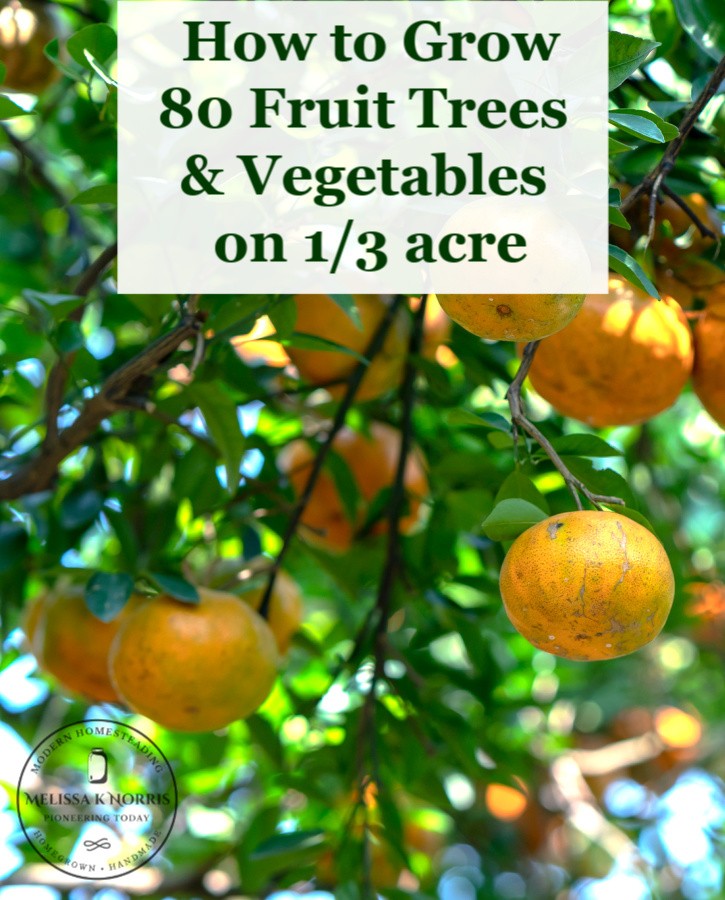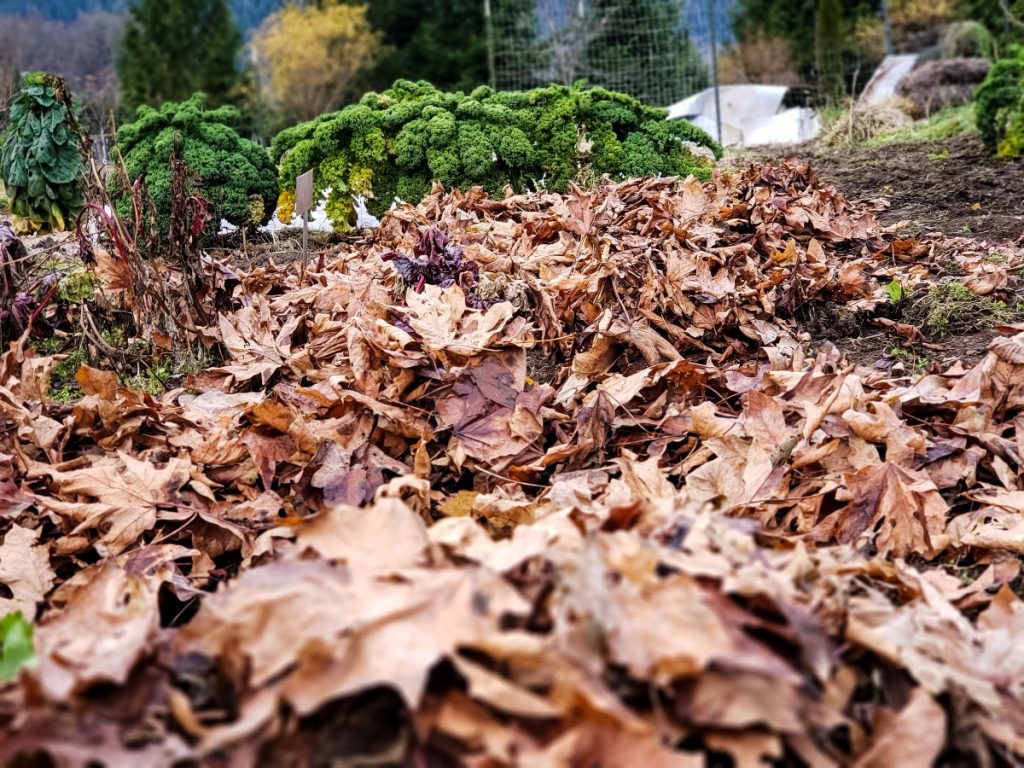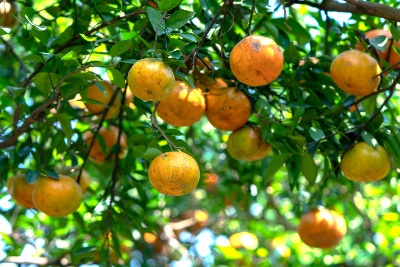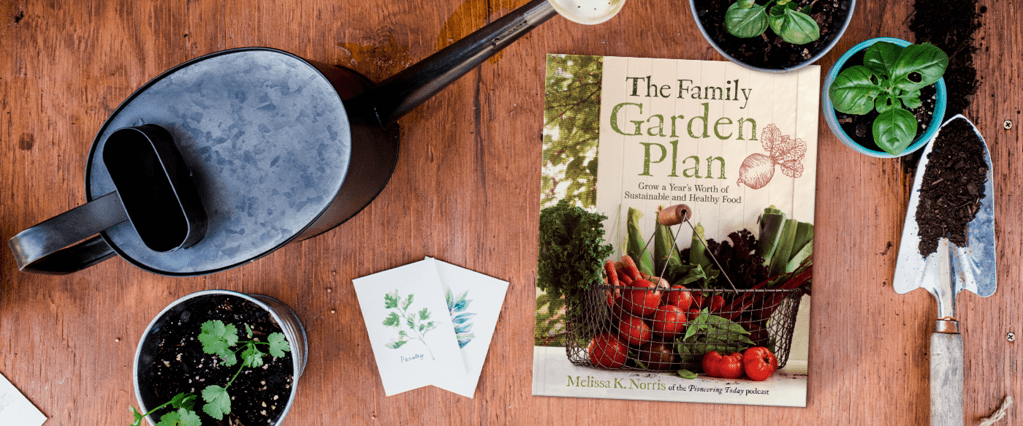When we think orchards and vegetables, enough to feed a family and extra for a community, we typically don’t think of a 1/3 acre in the middle of Phoenix Arizona, but that’s exactly what’s happened and what we’re going to break down for you today!

Listen in below to the full podcast, Episode #223 Urban Farming: 80 Fruit Trees on 1/3 Acre with Vegetables of the Pioneering Today Podcast, where we don’t just inspire you, but give you the clear steps to create the homegrown garden, pantry, kitchen and life you want for your family and homestead.
It’s so energizing to speak with fellow gardeners and my conversation with Greg Peterson from the Urban Farm definitely reinforced that as he feels the same way. Greg grew up in an urban environment, living in the middle of Phoenix starting when he was just six years old. Even as a child he was fascinated with all things gardening, starting with the concept of flood irrigation. Flood irrigation is where water is delivered to the field (or in his family’s case, yard) by ditch, pipe or some other means. The water flows over the ground and into the crop. For more in-depth information on flood irrigation click here.
He’s always been interested in sustainability, whether it’s using all the resources on a fish farm in a regenerative way or the application of permaculture. In his words, he calls permaculture “the art and science of working with nature.” I’ve been using a method, sheet mulching, that’s embedded in permaculture. Refer to my podcast on sheet mulching for more details.
In 1991, Greg created a vision for him to be the person on the planet responsible for transforming our global food system. Big goals for sure but as he says, “Well, why not?” From his early interest in gardening and sustainability, to his lofty goals, things were starting to coalesce for him. What clicked everything into place was when a friend of his went to the South Pacific on a sailboat, anchored on a small island and went looking for a grocery store. The people on the island looked at his friend funny and said, go pick your own.
In 2001, while at Arizona State University getting his bachelor’s and masters degrees, he wrote a paper reinventing his vision for his life. In that paper he created the urban farm, which is where he has been living for 30 years. It’s a lot that is 80 feet wide and 160 feet deep..only 1/3-acre. It’s a flood irrigated property much like the lot he grew up on as a kid. He purposely bought the property because it had that flood water. The house was built in 1948 and is now where he does classes as well as tours of the property.
He calls it an environmental showcase home with an entirely edible yard. There are over 80 fruit trees on the property as well as chickens in the backyard, solar panels on the roof, rainwater and grey-water harvesting. He’s definitely living a greener lifestyle which is one reason why I’m excited to be talking to him. We’ll also be learning tips to go from being a hobby gardener to feeding your family and then the community.
Growing in an Urban Desert
Melissa: With you being in an urban environment, are you worried about contaminants in the floodwater?
Greg: I have two answers for that. First, the water actually comes from Northern Arizona, comes down through the rivers and a series of canals that then feed the Phoenix metropolitan area. There are about 4.8 mill people in the Phoenix metropolitan area and it’s our drinking water so it gets cleaned and is also used as our flood water. The second answer, which is the sad part, is that we live in a very polluted world. I personally believe we can’t go anywhere on the planet that isn’t polluted in some way, shape or form. So we can just do the best that we can do. There may be stuff in there but there isn’t much I can do about it. Even the water that comes into my house has stuff in it, fluoride and chlorine. So we just have to be aware as best as we can.
Melissa: I love that answer. You just have to do the best with what you have with where you’re at, with what you know at the time.
Know When to Grow
I’d like to get an understanding about your growing environment there in Arizona since it’s so different from mine. Based on research I’ve done I assume that the majority of your growing is done not in the summer because it’s so hot. Are you able to still grow quite a bit during the summer? If so, what are ways you achieve that? What are things you’ve learned from growing in that environment?
Greg: The biggest thing that people need to address when they start growing in the desert is planting the right thing at the right time. About 18 years ago a friend of mine, Matt, and I put together a desert planting calendar, which is downloadable for free on my website. We do have four growing seasons and can grow all year round. And you’re correct, a majority of what we grow is between October 1st and June 15th. The window of July, August, and September is the hardest and hottest time to grow.
Pumpkins, cucumbers, melons, squash and those kinds of things can grow in that window but it’s really hard. When it’s 115 degrees outside, first of all, the plants don’t want to be out there, but you sure don’t want to be out there either. So number one is making sure that you know what to plant when, and I help people with that with my planting calendar.
Build Your Soil
Secondly, desert soils have less than 1% organic matter. One of the things that I teach about is building healthy soil. I have a series, Healthy Soil Hacked, that shows people how to build and create healthy soil.
There are five components of healthy soil:
- dirt (broken down rock)
- airspace
- water
- everything that’s alive in the soil
- organic matter
The really cool thing is that to fix broken soil in the desert, you add organic matter. Over time that airspace shows up as well as percolation for the water and all the living creatures that live in the soil…simply by adding organic matter. So if you’re putting in a garden in the desert, get a good planting mix for your garden beds. One of my favorite stories that I tell when I’m lecturing is about Jan’s instant garden. She had an east facing garden, which means it gets sun in the morning, which is the perfect place when gardening in the desert. Her garden bed was four feet wide and 14 feet long with a brick border around it with no noxious weeds growing in it.

I put eight inches of planting mix in there. While I was unloading the planting mix she was planting the seeds. All told it took 47 minutes to install her garden. Take note, I didn’t do any digging because I put eight inches of planing mix on top. I let the roots do the work. I’m a lazy gardener and look for every opportunity to let nature be.
Let Nature Do It’s Thing
My late friend, Toby Hemenway, always used to say, “Nature always bats last.” We as human being thing that we know how to do it better than nature. In 1996 I wrote this, “Our downfall as a species is that we’re arrogant enough to think that we can control mother nature and stupid enough to think it’s our job.” That’s what I love about permaculture which I call the art and science of working with nature. How do we work in the flow of nature? When we pay attention to nature and let nature do the work for us? Life is so much easier.
Melissa: I have a big fondness for perennials now. I still grow my annuals but perennials really are less work and more food over time. I still do annuals because I’m not giving up my tomatoes and that kind of stuff but yeah, perennials by far require the least amount of work and babying overall.
Greg: My favorite thing thing to plant is a fruit tree because you plant it once and it’ll make fruit for many years. I have two citrus trees in my backyard that are 90 years old.
Melissa: So in the desert timing is key. If September is the wrong time to plant cucumber then I assume it would have been better planted in a little bit later, like October? Or am I wrong?
Greg: No, we actually get freezing temperatures here so any plants that aren’t cold tolerant will be killed when our temps get down into the 20’s. What we’re planting now (beginning of December) are greens, kales, brassicas, snow peas, and garlic. I’m sure I’m missing a few. Those kinds of things that overwinter very nicely here. The time to plant cucumbers is in March and April, after it warms up a little bit.
Melissa: When you you typically get those cold temps then?
Greg: We usually get freezing temperatures from around December 15th to February 1st.
Melissa: So right now you’re still harvesting quite a bit then?
Greg: Oh yeah. We have all our greens, brassicas, carrots, beets, and a lot of that stuff. I designed my yard here like a food forest which means I also let things go to seed. Last year I had this curious thing happen. I bring in interns and last year I had an intern who I gave four ounces of carrot seeds and asked him to plant a few rows. Now, four ounces of carrot seeds can easily be 50,000 seeds. It’s a lot. He planted them all. So I had a bumper crop of carrot seeds this last season. I didn’t get any carrots because they were too close together and I wasn’t going to thin out the plants. So I just let them all go to seed. But what happened was that a lot of those seeds just dropped on the ground. I now have a nice crop of carrots that just planted themselves out from last year. At any given moment in the yard, there are 20 to 40 different things that grow naturally that I can harvest. I don’t plant them anymore. I have:
- parsley
- oregano
- thyme
- rosemary
- cow peas
- carrots
- lettuce
Going back to permaculture principles…let nature be. If you let this stuff go to seed and then just spread the seeds, it’ll come back and you’ll have food to harvest.
Melissa: I have the exact same deal. I don’t have to plant:
- dill
- calendula
- chamomile
It almost feels like I’m cheating.
Tips to Evolve from a Gardener to a Farmer Feeding Others
With urban gardening, I love your philosophy to first feed yourself and then to feed others. Talk about that evolution.
Greg: First of all, this notion of lack, of not having enough…I believe there is one place on the planet that that concept lives. And that’s between our ears. Because when I look at the amount of abundance that comes out of my yard right now…from my close to 80 fruit trees on a third of an acre here in Phoenix, if I were to harvest it all right now, I’d literally have a ton. As in 2000 pounds of fruit. So when I look at it from the perspective of growing there is a lot of opportunity.
Shift Your Thinking

Over the course of the last 30 years, I’ve shifted from being a gardener to being a farmer because a gardener is a hobby. Generally speaking being a farmer is a profession. When you shift your thinking from just growing a little bit of food to growing food and sharing it, even if it’s just family and friends, it does something to your brain. I believe it brings on more abundance. So my pathway to starting your urban farm or starting your farm, whether urban or not, is to grow food to share.
Name Your Farm
And then name your farm. Since I started this conversation about 14 years ago here in Phoenix there are thousands of people in Phoenix that have named their farm.
My friend Melanie lives in an apartment and she calls her farm Two Fat Cats Apartment Garden. Many of you may have laughed at that. That name lightens up the space, it made it a happy space. When you have a party at your house, where do people usually gather? Around the food or in the kitchen…because food is a happy thing. What I’m proposing is that we get back to food being a happy thing rather than something that you go to the grocery store and buy.
So the naming part is a really key piece. It brings a level of authenticity and realness to the concept of growing food, which we so need in our culture right now.
Melissa: I completely agree. I say homesteading and gardening are a state of mind first. It really is. Once you determine and say this is what I am and what I’m doing, even though my circumstances aren’t ideal, it does something. I have a member, Anna, of my Pioneering Today Academy, who has also been a guest on my podcast, who started out in an apartment, not even knowing how to cook from scratch, let alone grow anything. They started out in an apartment, rented for a few years, and recently purchased their first suburban homestead. Like you said, it was that mindset first. That mindset proceeds the actions that you’re going to take that are going to get you those results. What you don’t know, you’re going to figure it out. You’re going to use resources and your going to learn. Those skills will build upon each other.
Start Easy
Are there any other tips or bits of wisdom that you’d like to share?
Greg: Growing food is simple and you can overwhelm yourself. A few years ago I had a young lady on a tour here and as you can imagine with a third of an acre with 80 fruit trees, chickens, solar panels, and rainwater/grey-water harvesting it can be quite overwhelming. Toward the end she said, I’m so overwhelmed here. Where do I start?
What I shared with her was this: Pick one or two things that inspire you that’s exciting, that you can really get into and do that first. It may be just growing some herbs in a pot. I tell people to grow herbs all the time. They’re the most expensive thing to buy and the easiest to grow. And they can be grown in pots. So pick one thing and be successful with that.
What’ll happen if you try too many things and aren’t successful with them, you get disappointed and you stop. That’s the last thing we want you to do is stop. So start easy.
Resources:
Sheet Mulching: The Easy Way to Build Soil
Self Sufficient Homesteading Tips for the Long Haul – Anna shares how she learned and applied homesteading skills even though they’re not on their ideal property
Where to Find Greg:
Preorder my new book today The Family Garden Plan to take advantage of all the bonuses! In this book, you’ll learn how to grow a year’s worth of food for your family! Increase your harvest and maximize the space you have using organic and natural methods to raise a year’s worth of the fruits and vegetables your family enjoys with Melissa’s step-by-step plans and charts.




